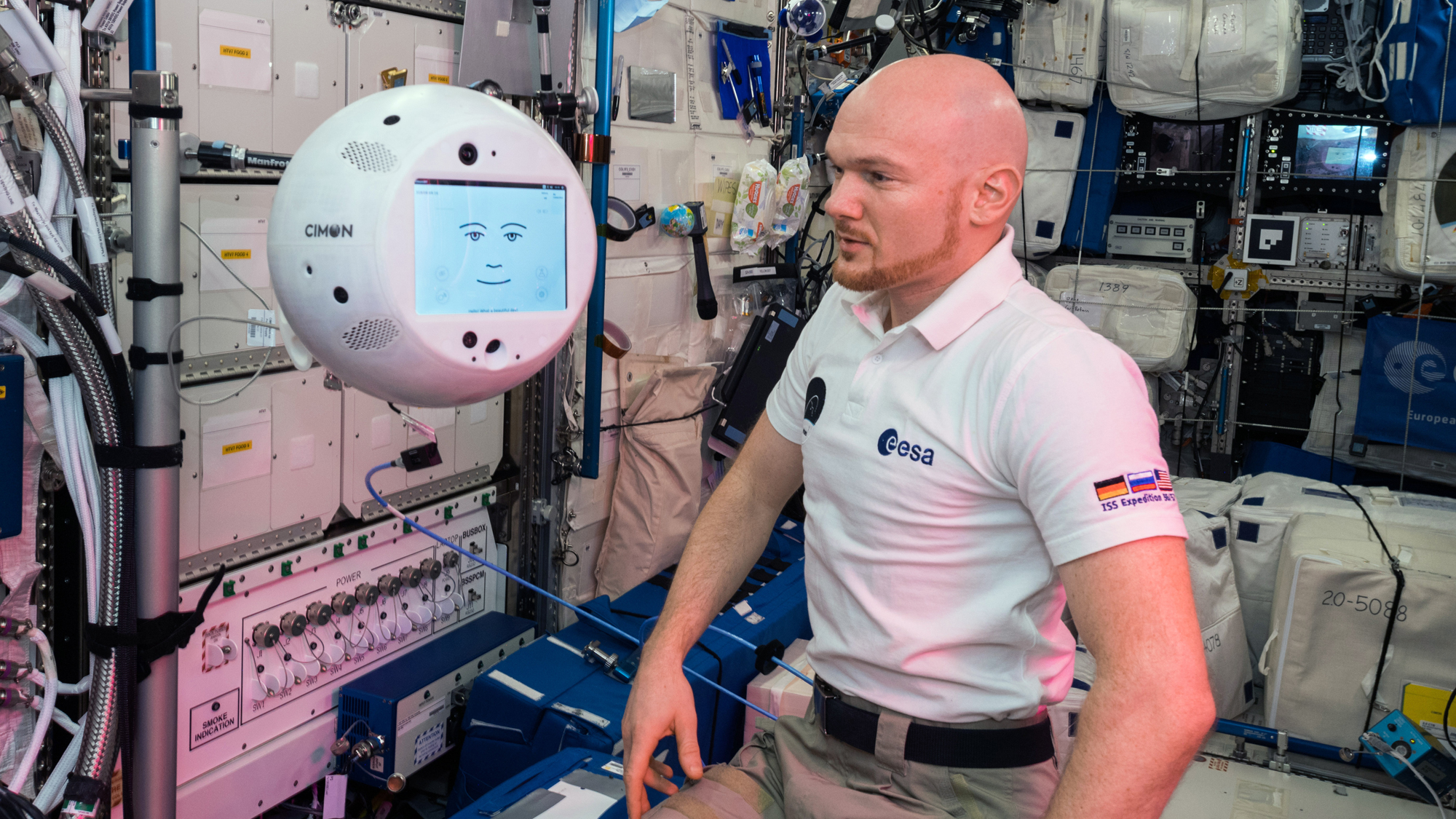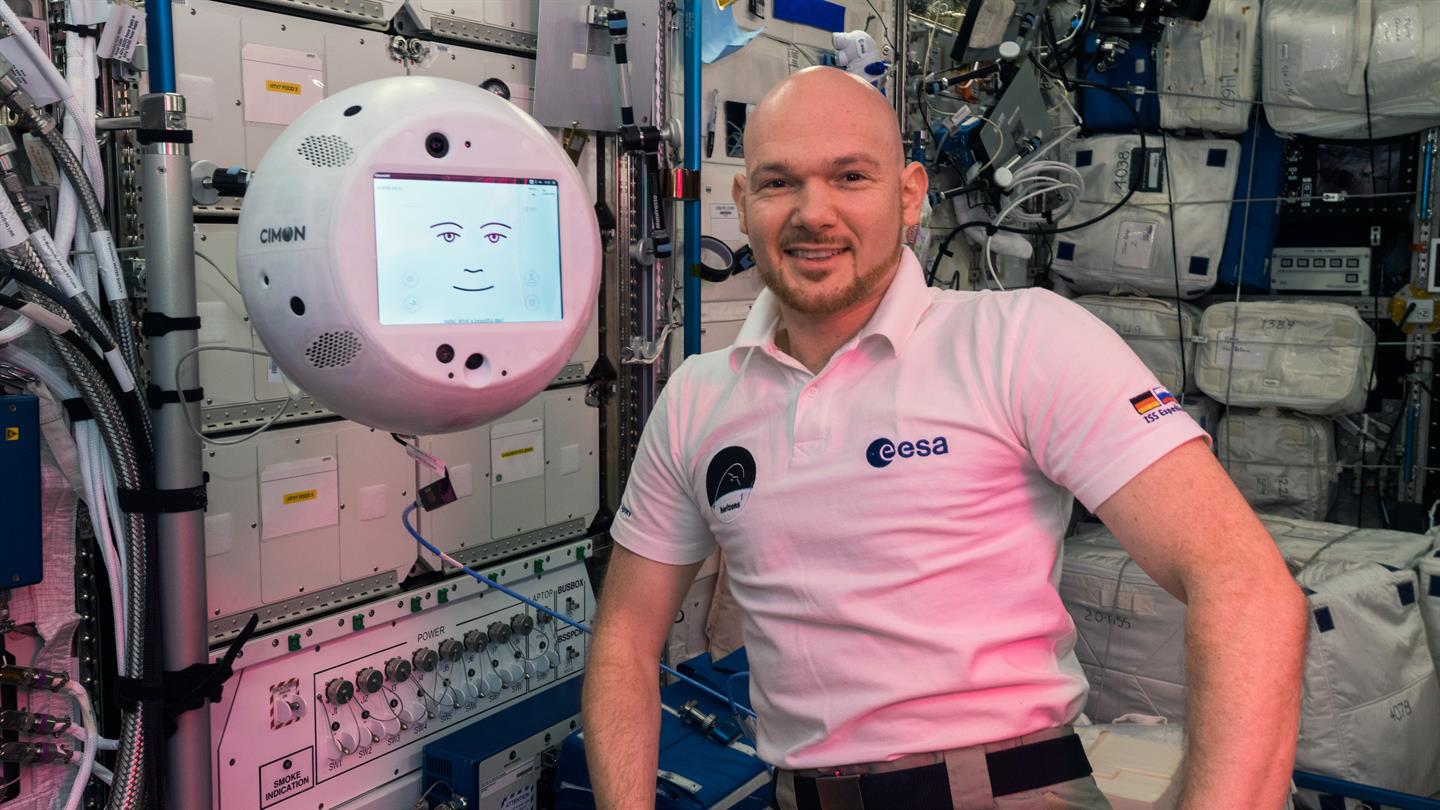AI Robot CIMON Debuts at International Space Station
The space station robot CIMON has exchanged its first words with its spacefaring crew.
German astronaut Alexander Gerst talked with the artificially intelligent crew-assistant CIMON during a 90-minute experiment on Nov. 15 aboard the International Space Station (ISS).
According to a statement from the manufacturer, Airbus, Gerst, the commander of the current space station crew, woke up CIMON (the Crew Interactive Mobile CompanioN) with the words "Wake up, CIMON." In response, CIMON said, "What can I do for you?" [This Flying Space Droid Wants to Make Friends with Astronauts]

During the experiment, CIMON successfully found and recognized Gerst's face, took photos and video, positioned itself autonomously within the Columbus module using its ultrasonic sensors, and issued instructions for Gerst to perform a student-designed experiment with crystals.
Weighing about 5 kilograms (11 lbs. on Earth), the 3D-printed robot designed jointly by the German space agency DLR, Airbus and IBM works similarly to Apple's virtual assistant Siri or Amazon's Alexa. CIMON doesn't process commands itself, but instead communicates with a ground-based cloud computer — IBM's natural-language-processing computer Watson.
"If CIMON is asked a question or addressed, the Watson AI firstly converts this audio signal into text, which is understood, or interpreted, by the AI," explained IBM project lead Matthias Biniok in the statement. "IBM Watson not only understands content in context, [but] it can also understand the intention behind it."
The computer provides a tailored answer to an astronaut's query, and this answer is then converted into speech and beamed back to the ISS. CIMON is connected to the ISS Wi-Fi network that transmits data via satellite connections to the ground.
Get the Space.com Newsletter
Breaking space news, the latest updates on rocket launches, skywatching events and more!

Marco Trovatello, a spokesman of the European Space Agency's Astronaut Centre in Cologne, Germany, told Space.com that CIMON could respond within a couple of seconds after a question was asked, no slower than in ground-based tests.
A data link connects CIMON with the Columbus control center in Germany; from there, the signal travels first to the Biotechnology Space Support Center at the Lucerne University in Switzerland, where CIMON's control team is based. Then, the connection is made over the internet to the IBM Cloud in Frankfurt, Germany, Bernd Rattenbacher, the team leader at the ground control centre at Lucerne University, said in the statement.
CIMON, Trovatello said, is not yet a fully fledged AI crewmember like the film "Interstellar's" TARS or the famous HAL 9000 from Stanley Kubrick's iconic movie "2001: A Space Odyssey." CIMON is rather a first step, designed to test what future human-robot interaction in space might look like.
"CIMON is a technology demonstration of what a future AI-based assistant on the International Space Station or on a future, longer-term exploration mission would look like," Trovatello said. "In the future, an astronaut could ask CIMON to show a procedure for a certain experiment, and CIMON would do that."
The spherical robot has a large screen at the center that either features a simple, friendly, cartoon-like face or displays required information for experiments and repairs.
With its ability to float around and receive spoken commands, CIMON could save astronauts a lot of time during experiments and help them perform more efficiently, officials said.
"Now, they have to float to a laptop and look up the procedure," said Trovatello. "That costs a lot of time, which is really precious for astronauts."
Trovatello said that with the experiment last week, CIMON's cooperation with Gerst has ended. Gerst will return to the Earth in December. His successor, the Italian astronaut Luca Parmitano, is scheduled to fly to the ISS next year and will likely continue with further experiments, Trovatello said.
Follow us on Twitter @Spacedotcom and on Facebook. Original article on Space.com.
Join our Space Forums to keep talking space on the latest missions, night sky and more! And if you have a news tip, correction or comment, let us know at: community@space.com.

Tereza is a London-based science and technology journalist, aspiring fiction writer and amateur gymnast. Originally from Prague, the Czech Republic, she spent the first seven years of her career working as a reporter, script-writer and presenter for various TV programmes of the Czech Public Service Television. She later took a career break to pursue further education and added a Master's in Science from the International Space University, France, to her Bachelor's in Journalism and Master's in Cultural Anthropology from Prague's Charles University. She worked as a reporter at the Engineering and Technology magazine, freelanced for a range of publications including Live Science, Space.com, Professional Engineering, Via Satellite and Space News and served as a maternity cover science editor at the European Space Agency.









